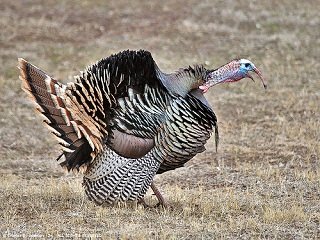
If you have even limited experience turkey hunting, then you know how hard it can be to bag a late season gobbler. Since most turkey seasons are regulated to coincide with the actual turkey mating season, one only has to know what is actually happening at the end of breeding season to figure out the best strategy to bag a trophy gobbler.
By the time the breeding season comes to a close, male turkeys are worn out from maintaining their strutting zones and from servicing all the local female turkeys. Not only are they exhausted, but they are also weary when they hear a hunter making the calls of an early-season hen ready to find a mate.
Since mature gobblers are actually the ones doing the breeding, they know exactly what the state of breeding is in the local turkey community. When a hapless hunter sits down within hearing distance of a big tom and starts calling like its early season, he will be disappointed. That old tom is likely high-tailing it out of the area. He knows it’s a trick and not only will you not kill him, but you have just educated him for any future attempts as well.
I have learned a few things after many years of being a turkey guide, and one of them is to make it easier for the turkey to take an interest in you. One of my best tactics is to imitate another old gobbler. Mature gobblers at the end of breeding season are cranky, and they don’t like being inconvenienced.
When they are perturbed, they will investigate as long as it is not too much of an effort. So try to get as close to their strutting zone as possible, and make a few calls that resemble an older bird. Young toms sound pretty and sharp in high tones, but old gobblers often sound like marbles in a metal can. In fact, some of them only have the cadence of a gobble, but not the tone or pitch of a gobble.
I give them a few deep and awkward gobbles, and then I will flap my hat on the ground to simulate a flapping wing of a mating bird trying to keep his balance while mounting a hen turkey. Then I shut up. More times than not, my target bird will simply have to come investigate as long as it is not more than 50-70 yards from his strutting zone. He will often not answer, but he will come, and he will be making the spitting noise that upset gobblers are famous for.
I can honestly say that the method described above is about 70% successful. When it does not work, I simply sneak into shotgun distance and take care of business. This is also the best time of the season to sneak up on a strutting gobbler as he is expecting noise from other turkeys and you can use his fanned tail as cover as it blocks his eyes from seeing you come up behind him.
When you find yourself having to do some last minute turkey hunting at the end of the season, don’t act like a hen turkey wanting to eagerly mate, act like another grouchy gobbler and bag that bird.
Take a look at our Top 5 Shotguns for Turkey Hunting








